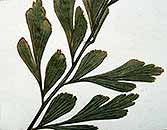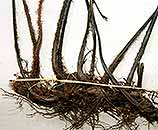Asplenium buettneri Hieron.
Synonyms |
Asplenium parablastophorum A.F. Braithw. |
|---|---|
Common name |
|
Description |
Rhizome thin, up to 4 mm thick, creeping or erect; rhizome scales dark brown, entire, subulate, up to 2-5 x 0.3-0.6 mm, apex gradually tapering, ending in a hair-point. Fronds clearly spaced apart, erect, glabrous, not proliferous, thinly coriaceous to thinly herbaceous. Stipe 6-37 cm, dull brown to black at least at the base, scales dark to mid brown. Lamina 8-26(-30) × 4-15(-18) cm, 2-pinnate to 3-pinnatisect on the lower pinnae, basal pinnae not or hardly reduced, triangular-ovate in outline. Pinnules elongate-obcuneate in outline, base asymmetrical, margins toothed, venation flabellate. Rhachis very dark to almost black dorsally, green and grooved ventrally, not or sometimes narrowly winged, with brown lanceolate scales up to 1.5 mm long. Sori 3-13 mm long, linear, set along the veins, with more than one per lobe; indusium entire, lineair, membranous, 0.4 mm wide. |
Notes | Differs from similar species by having a very thin rhizome and almost black stipe and rhachis.F.T.E.A. distinguishes var. buettneri (rhizome short-creeping to erect, fronds tufted, rhizome scales 0.4-0.6 mm wide) and var. hildebrandtii (long creeping rhizome, fronds clearly spaced, rhizome scales narrow, to 0.3 mm wide). |
Derivation | buettneri: named after O.A.R. Büttner, a German plant collector. |
Habitat | Moist evergreen montane forest, riverine forest, rock crevices, deciduous miombo woodland. |
Distribution worldwide | |
Distribution in Africa |
Burundi, Cameroon, Central African Republic, Dem. Republic of Congo, Equatorial Guinea (incl. Bioko), Ethiopia, Gabon, Ghana, Guinea, Kenya, Liberia, Malawi, Mozambique, Nigeria, Rwanda, Sudan and South Sudan, Tanzania , Togo, Uganda, Zambia, Zimbabwe. |
Growth form |
Epiphytic, lithophytic, terrestrial. |
Literature |
|



